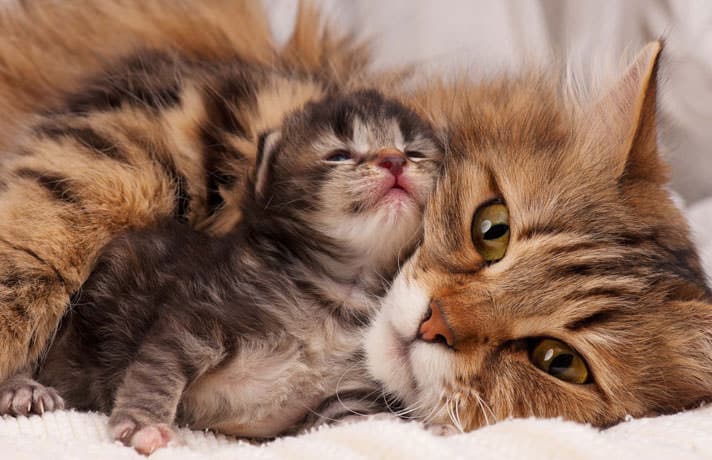Let’s start with the good news first: Sneezing in cats and kittens is relatively normal and can be caused by a variety of factors, which are oftentimes mild and even harmless. The occasional sneeze is a normal reflex and usually nothing to worry about. (Plus, it can also be super cute!) But if your cat’s or kitten’s sneezing becomes frequent or is accompanied by other symptoms, it may indicate an underlying health issue.
So, how do you know what’s causing your cat’s sneezing, and when to call your vet? We’re breaking down several common causes of sneezing in kittens and cats, the warning signs, and what pet parents can do to help their furry friends.
8 Common Causes of Sneezing in Cats and Kittens
1Irritants in the Nose
Irritants can cause inflammation in the nose, which can cause sneezing in cats. This can be caused by things like:
- Dust
- Pollen
- Perfumes
- Cleaning products
- Cigarette smoke
These irritants can cause inflammation in the nasal passages, leading to a sneezing cat. In many cases, this type of sneezing is harmless, and occasional sneezing is not a cause for concern. However, continued exposure to irritants can lead to a condition called rhinitis, which causes more sneezing and other respiratory symptoms and may require a visit to your vet.
Other Warning Signs
- Watery eyes
- Nasal discharge
- Coughing
- A picky appetite/eating less than usual
Is My Cat at Risk?
All cats who are exposed to irritants can experience inflammation and, with continued exposure, rhinitis.
How to Help
Try to keep your home clean and free of irritants that can trigger sneezing. Avoid smoking in the house and using harsh cleaning products. Do not use essential oils or scented candles if you have cats (or birds, who are also sensitive to irritants) in your home. Consider using a humidifier to moisten the air, which can help reduce irritation in the nasal passages.
2Allergies
Cats can develop allergic hypersensitivities to a wide range of substances, including:
- Pollen
- Dust
- Mold
- Food
Hypersensitivities can cause inflammation in the nasal passages, sometimes leading to sneezing and other respiratory symptoms. Sneezing due to allergies is usually seasonal. Cats with sneezing due to seasonal allergies are otherwise usually healthy, happy and bright.
Other Warning Signs
In addition to sneezing, symptoms of seasonal allergies include:
- Coughing
- Itchy skin
- Watery eyes
- Nasal discharge
- Skin irritation
- Hair loss
Warning signs of food allergies include:
- Vomiting
- Diarrhea
- Picky appetite
- Excessive gas
- Skin Irritation
- Hair loss
Is My Cat at Risk?
Cats of any age can develop allergies, but it's more common in younger and middle-age cats. Outdoor cats may be more at risk for seasonal allergies due to their exposure to pollen.
How to Help
If you suspect your cat has allergies, try to identify the allergen and remove it from your home. Talk to your veterinarian about managing your cat’s allergy symptoms. Anti-inflammatory and antibiotic ointments, antihistamines, prescription medications and a prescription diet (for food allergies) can be helpful in managing your cat’s symptoms.

3Upper Respiratory Viral Infections
Upper respiratory infections are common in cats, particularly in kittens and cats in shelters or crowded environments. These infections can be caused by a variety of viruses and bacteria, including feline herpesvirus and feline calicivirus. Sneezing is a common symptom of upper respiratory infections.
Other Warning Signs
- Runny nose
- Coughing
- Decreased energy levels
- Decreased appetite
- Hiding from others in the home
- Fever
- Bad breath (from mouth ulcers)
- Conjunctivitis, a condition that causes red, watery eyes
Is My Cat at Risk?
Cats of any age can develop upper respiratory infections, but they are more common in kittens and cats in crowded environments or cats that are stressed.
How to Help
If you suspect your cat has an upper respiratory infection, keep them warm and comfortable, and provide plenty of fluids. If possible, use a humidifier to offer “steam therapy.” You can also speak to your veterinarian about medication to help manage your cat's symptoms.
4Upper Respiratory Bacterial and Fungal Infections
Bacterial or fungal infections can cause inflammation in the nasal passages, leading to sneezing and other respiratory symptoms. Bacterial infections can be secondary to upper respiratory viral infections and dental issues. Fungal nasal infections are (aka short-nose or “smush-face” breeds like Himalayans, Exotic Shorthairs and Persians).
Other Warning Signs
- Coughing
- Colored (yellow or green) nasal discharge
Is My Cat at Risk?
All cats can develop bacterial or fungal infections, but the risk is higher for cats who:
- live outdoors
- were exposed to upper respiratory viruses as a kitten
- have FeLV (feline leukemia) and FIV (feline immunodeficiency virus)
- are brachycephalic breeds
How to Help
Keep your cat indoors unless they are outdoors with supervision or in an outdoor enclosure, and make an appointment with your vet if you notice the warning signs above. Upper respiratory problems are worse with stress, so manage your cat’s stress and provide indoor enrichment like toys and scratchers. If your cat has recurrent problems, talk to your vet about immune support supplements.
5Dental Disease
Dental disease in cats can cause inflammation in the mouth and nasal passages, leading to sneezing.
Other Warning Signs
- Red gums
- Decrease in appetite
- Bad breath
- Changes in the way your cat eats (i.e. they are chewing differently or prefer wet food)
- Drooling
- Bloody saliva
- Lethargy
- A swollen face (in severe cases)
Is My Cat at Risk?
Any cat is at risk for dental disease. In fact, most cats over the age of 4 have some level of dental disease.
How to Help
If you haven’t already, start a home dental care routine with your cat. Use cat-safe dental products to promote dental health. It’s important to also have your cat’s teeth examined by a veterinarian yearly and cleaned by a veterinarian if necessary.
Find out how to brush your cat’s teeth. (Yes, it is possible!)
6Nasal Polyps and Tumors
Nasal polyps are non-cancerous inflammatory tumor-like growths that occur in the nose, throat and ears of cats. They may have a viral or genetic origin, and can cause sneezing in kittens and cats. Cancerous nasal tumors can also occur inside cat noses and have many of the same signs as nasal polyps.
Other Warning Signs
- Noisy breathing
- Nasal discharge
- Bloody nose
- Gagging
- A change in the sound of their voice
- Droopy eyelid
- Head tilting
- Symptoms do not improve with antibiotics
Is My Cat at Risk?
Polyps mostly are seen in young cats and kittens, but can be seen in older cats as well.
How to Help
Surgical removal by a veterinarian is required, and sending the polyp in for biopsy is recommended after surgical removal to ensure it’s not a sign of an underlying health issue.

7Foreign Object in the Nose
No, most cats aren’t intentionally sticking random items into their nostrils—but curious kittens or cats who like to eat grass may get a blade of grass stuck in their nose, which in turn leads to sneezing.
Other Warning Signs
- Sudden onset of violent sneezing
- Reverse sneezing (a sudden inhalation of air through the nose that can sound like honking or wheezing)
- Pawing at the face
- Bloody nose
- A visible blade of grass sticking out of the nostril
Is My Cat at Risk?
If your cat likes to eat grass, they are at risk.
How to Help
If you can see the grass in your cat’s nose, you might be able to pull it out. However, in most cases cats or kittens need to be sedated to remove the grass. Call your veterinarian for assistance.
8Recent Vaccinations
Vaccinations are essential for protecting your cat against a range of diseases, but they can sometimes cause mild, transient side effects, including sneezing. This is usually a minor reaction and should resolve on its own within a few days.
Other Signs
There’s no definitive sign that a sneeze is related to a recent vaccination—but if your cat or kitten’s sneezing began shortly after they received a vaccine, there’s a good chance the two are related.
Is My Cat at Risk?
Any cat who receives a vaccine can experience sneezing as a side effect.
How to Help
Just like humans, cats can sometimes feel a little under the weather after getting their shots. Keep an eye on your cat's symptoms and give them plenty of rest and fluids. If your cat's symptoms persist for more than a few days, or your cat is acting otherwise sick in any way, speak to your veterinarian.
While the assistance of a veterinarian is often needed to resolve cat sneezing, there are some things you can do at home to help your cat:
- Look for patterns in when and where your cat sneezes and see if you can figure out what is causing the problem—then eliminate it if possible.
- Avoid using irritating cleaning products around your cat. If you must use them, try to remove your cat from the area, rinse well and keep the area well ventilated until cleaning products are fully dry.
- Avoid using excessive perfumes or body sprays around your cat if that causes sneezing or irritation.
- Use low dust cat litter and an uncovered litter box.
- Run a humidifier and use a HEPA filter in your furnace and carpet.
- Avoid using essential oil diffusers or scented candles around your cat.
When to Call Your Vet
While many cases of cat sneezing are mild and will resolve on their own, sometimes the sneezing is caused by a more serious underlying cause or could limit your cat’s ability to breathe. If your cat shows any of these signs, they could be seriously ill and should be taken to the veterinarian immediately or that same day:
- Bloody nose
- Swollen face
- Violent sneezing fits that don’t get better
- Pawing at face
- Loss of appetite for more than one day
- Vomiting
- Excessively lethargic
- Uncharacteristic aggression
- Seizures or tremors
- Trouble breathing or blue gums
- Continual open mouth breathing
- Other unusual behaviors (head pressing, circling, excessive vocalization, head continually titled to one side, non-responsive to name, falling to one side)
If your cat is sneezing and has colored nasal discharge, it’s probably not a same-day emergency, but you should call your vet to be seen as soon as possible.
And even without the above symptoms, if your cat keeps sneezing for more than a day or two, it’s time to make an appointment with your vet.
More Cat Health Tips:
Share:


















